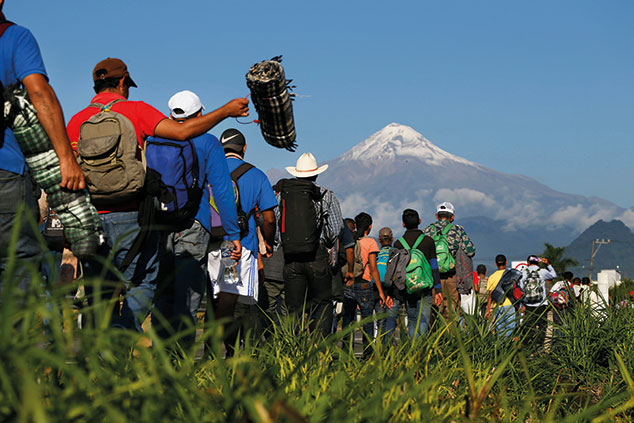
Are the numbers of migrants rising?
Yes, exponentially. The number of asylum seekers and refugees fleeing violence and persecution in central America has surged from about 18,000 in 2011 to 294,000 last year. The main reason is clear. The three nations of central America’s “Northern Triangle” – Guatemala, Honduras and El Salvador, in total home to about 33 million people – are all in the grip of complex crises involving grotesque levels of murderous gang violence, extortion and wholesale corruption at all levels of the state. Weak and corrupt governments have been incapable of addressing these issues (and raise the lowest levels of tax as a proportion of GDP in Latin America). For a growing number of people, threatened by the effective takeover of their areas by armed gangs, or unable to feed their families, fleeing is the least bad option.
What’s the scale of the violence?
Last year El Salvador was the deadliest place in the world that was not at war, with 60 murders per 100,000 people. Honduras’s murder rate is forecast to be 41 per 100,000 this year (and almost all murders are unsolved). The murder rate in the US, by comparison, is a little more than five per 100,000 people and in the UK it’s slightly more than one per 100,000. Of migrants from Northern Triangle countries, surveyed by Doctors Without Borders (MSF) in Mexico in 2015, more than 40% said that a family member had been killed in the past two years; 31% said they knew someone who had been kidnapped. As White House chief of staff John Kelly put it in 2014, as leader of US Southern Command, drugs cartels and local gangs, fuelled by the insatiable US demand for illicit drugs, “have left near-broken societies in their wake”.
What are the root causes of all this?
Decades of poverty, extreme inequality and civil conflict. In El Salvador and Guatemala, the entrenched power of organised crime is a legacy of decades of civil wars (in which US backing for “anti-communist” military-backed right-wing governments has been a constant). In El Salvador, the 1979-1992 war between the military government and leftist guerrillas left more than 75,000 dead. Guatemala’s civil war (1960-1996) killed up to 200,000. Honduras was sucked into neighbouring conflicts and for decades has acted as a US base for its military interventions. In the 1990s and early 2000s, the deportation from the US of thousands of convicted criminals fuelled the expansion of gangs. In recent years, the fragmentation of the drugs trade – with cartels splintering into warring groups – has increased the levels of violence and extortion of local people. On some estimates the MS-13 and Barrio 18 gangs may be El Salvador’s largest employers, with as many as 60,000 people on the payroll.
Is hunger a real threat?
Yes. Guatemala has the fourth-highest levels of chronic malnutrition in the world and half of its young children are stunted because they don’t have enough to eat. “The focus on violence is eclipsing the big picture, which is that people are saying they are moving because of… climate change,” says Robert Albro of American University in Washington DC. “The main reason people are moving is that they don’t have anything to eat. This has a strong link to climate change – we are seeing tremendous climate instability that is radically changing food security in the region.”
Why are these economies so vulnerable?
A third of all employment in central America is linked to agriculture (coffee, bananas, sugar), meaning that changes in weather patterns rapidly cause problems. In recent years, much of the region has been in the grip of drought, occasionally punctuated by heavy rains causing disastrous flooding. In addition, since around 2012 coffee plants across the region have been ravaged by leaf rust, affecting up to 70% of farms. Some researchers believe climate change has been a factor: normally the fungus dies when temperatures fall in the evening, but warmer nights are allowing it to survive and wreak havoc. Typically, say academics, rural families will first migrate to towns or cities, before deciding that a life of poverty and endemic violence is not tolerable, and make the decision to migrate.
Why do they all head to the US?
Not all do. Asylum applications in Mexico – mostly made by people from the Northern Triangle countries to its south – have risen more than 11-fold since 2013. Belize, Nicaragua, Costa Rica and Panama have all reported a sharp rise in inflows from the Northern Triangle countries over the past decade. But the US is the most attractive destination: it’s rich and peaceful and possible to reach – especially if travelling in a large group for reasons of safety. And the exodus from the Northern Triangle is just part of a wider surge in mass migrations across Latin America in recent years. Around 2.3 million people have fled Venezuela and sought refuge in neighbouring countries since 2014, for example, and Chile’s strong economy has seen the number of foreign residents surge five-fold in a decade to 750,000 (about 5% of the population). Political turmoil in Nicaragua has also led to mass migration to relatively prosperous, stable Costa Rica.
Will Trump’s policies stop the flows?
Given the scale of the crises, it looks unlikely. Tightening of the border has made getting to the US a much more dangerous and expensive journey for central Americans, but it hasn’t slowed the numbers coming. “The militarisation of our border is actually leading to increased migration,” according to Elizabeth Oglesby, an expert on the region at the University of Arizona. In the 1990s, it wasn’t expensive to travel north with a local smuggler. “Now it costs $10,000 or £12,000 for someone from Central America to migrate – criminal networks control the routes through Mexico. So once they go, they stay, because they can no longer come back and forth. The only way for families to be reunited is for the families to also try to go.”